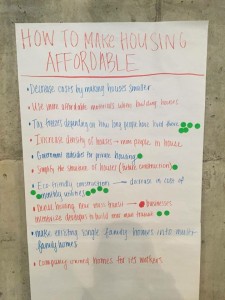Out of our ten different ideas to make housing more affordable, the three chosen most by the class were putting tax freezes on certain residents, depending on how long they’ve lived there, building with more eco-friendly materials, which will decrease the cost of monthly utilities, and allowing businesses or corporations to incentivize developers to build dense housing near mass transit.
A tax freeze means the tax rate does not increase for people who have lived in their homes for a long time. It helps prevent gentrification by making sure people who have lived in their neighborhoods do not need to worry about the area becoming too expensive to live in when new people move in. Take Brooklyn, New York for example. This area, for a long time, was a cheap place to live that was very close to downtown and midtown Manhattan. However, because of its cheap prices and proximity to Manhattan, many people purchased land and changed it causing gentrification and forcing people who could not afford to live in the neighborhoods to move out. If there were more tax freezes, people would have been able to afford to live in their neighborhoods plus all the new public goods that came with new residents.
Allowing businesses to give money to housing developments near mass transit will allow residents living there a reliable and relatively cheap mode of transportation. Because of this, business owners can more reliably know their workers will be able to get to work, giving them more reliable workers that regularly come to work on time, which gives them the incentive to pay for housing near mass transit. This practice makes these houses available to low income families. Additionally, these families will have a cost efficient way to get to work, lowering the cost of their daily commute.
Finally, our group’s favorite solution is to use more eco-friendly materials in construction. By doing so, the cost of utilities and the environmental impact will decrease. For example, using energy efficient windows will keep heat and air conditioning in, creating a more stable environment in which the amount of energy used to heat and cool the house will decrease, lowering the cost of utilities. Energy efficient appliances like lightbulbs, refrigerators, dishwashers, and air conditioners can also be installed to save on monthly costs. Other sustainable practices include using recycled building materials such as engineered lumber, fly ash concrete, steel, tile, or cotton insulation. Metal roofs can save on energy, collect rainwater, and can lower homeowners insurance. Landscaping around the house can be strategically chosen and placed to provide shading, cooling, and protection from wind and noise. While all of these eco-friendly practices make housing more affordable in the long run, they also improve occupant health, comfort, productivity, and reduce pollution and landfill waste.